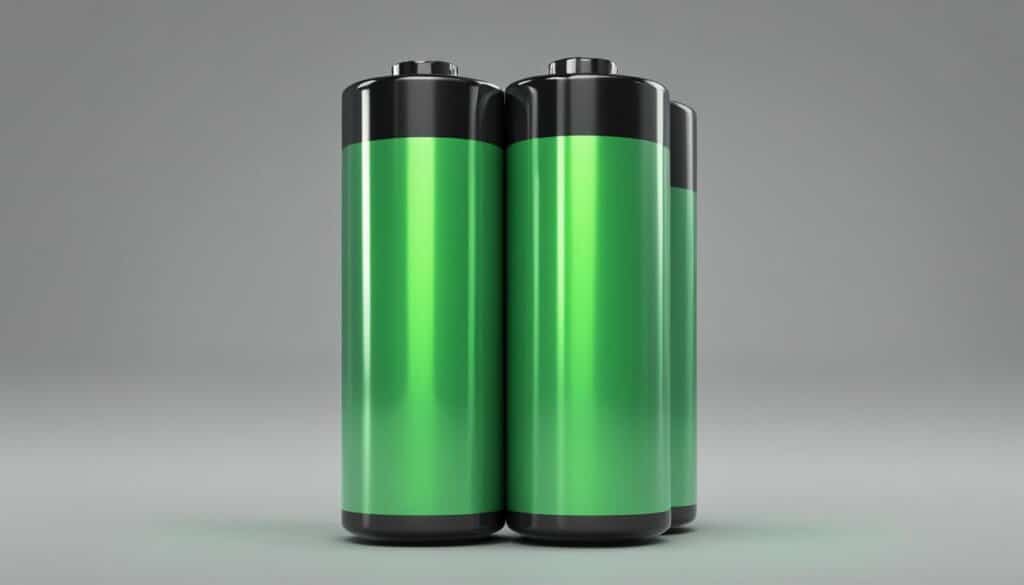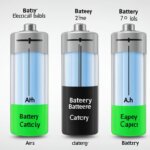Table of Contents
When it comes to battery performance, one crucial rating to understand is amp hours. Amp hours, often abbreviated as Ah, represent the amount of energy charge in a battery that enables 1 ampere of current to flow for one hour. This rating determines the battery capacity and indicates how much amperage the battery can provide for a specific period.
The amp hour rating can usually be found on the battery itself or in associated sales information. However, it’s important to note that the amp hour rating may vary depending on the C rating, which represents how many amp hours the battery can provide for a specific time period.
Rapidly discharging batteries can negatively affect their efficiency, so it is essential to choose the appropriate C rating for your specific needs. By understanding amp hours, you can make informed decisions when selecting batteries that will deliver optimal performance and meet your power requirements.
Finding the Amp Hour Rating
When comparing batteries, it is important to know where to find the amp hour rating. Deep cycle batteries, commonly used in applications such as solar systems or off-grid properties, usually have the amp hour rating clearly displayed on the battery or in the associated sales information.
On the other hand, starting batteries, which are not designed to provide continuous power in amp hours, may not have an amp hour rating specified. It is essential to ensure you are looking at the right type of battery and finding the correct amp hour rating to make an informed decision when purchasing a battery.
Deep Cycle Batteries
Deep cycle batteries are designed to provide a steady and continuous level of power over an extended period. They are commonly used in applications that require long-term energy storage, such as solar systems, RVs, boats, and off-grid properties. These batteries have a solid amp hour rating, indicating their capacity to deliver a specific amount of power over time.
Deep cycle batteries often have the amp hour rating clearly displayed on the battery itself or in the associated sales information. This rating helps consumers understand the battery’s capacity and determine whether it meets their specific power requirements. When comparing deep cycle batteries, look for the highest amp hour rating within your budget to ensure ample power supply for your needs.
Starting Batteries
Starting batteries, also known as automotive batteries, are primarily designed to deliver a high burst of power to start an engine. Unlike deep cycle batteries, they are not intended to provide continuous power over an extended period. Starting batteries are commonly used in cars, trucks, motorcycles, and other vehicles.
Due to their specific purpose, starting batteries may not have an amp hour rating specified. Instead, these batteries are typically labeled with cold cranking amps (CCA) or other performance metrics that measure their ability to deliver a rapid burst of power. When shopping for starting batteries, focus on features such as CCA and reserve capacity to ensure reliable engine starting.
Amp Hour Calculation and Battery Capacity
Calculating the amp hour rating, also known as the battery capacity, is essential for understanding the performance and endurance of a battery. The amp hour rating can be determined by multiplying the current (in amperes) by the discharge time (in hours). This calculation provides an accurate representation of how long the battery can provide a certain amount of current.
To calculate the amp hour rating:
- Identify the current (in amperes) that the battery can supply.
- Specify the discharge time (in hours) over which the battery will provide the current.
- Multiply the current by the discharge time to obtain the amp hour rating.
For example, if a battery can supply a current of 10 amperes for 5 hours, the amp hour rating would be 50 ampere-hours (Ah). This means the battery can provide 10 amperes of current for 5 consecutive hours before requiring recharging.
In addition to the amp hour rating, it is crucial to consider the C rate when evaluating battery capacity. The C rate represents the battery’s charging and discharging ability, indicating how quickly the battery can release energy and how efficiently it can be replenished.
Tip: Higher C rates are generally associated with batteries that can provide higher amp hour ratings. However, it’s important to note that batteries with high C rates may have reduced overall capacity. Finding the optimal balance between C rate and amp hour rating is essential for determining the battery’s capacity accurately.
Understanding the battery’s capacity is vital for choosing the right power source for your specific needs. Whether it’s for consumer electronics, electric vehicles, or off-grid solar systems, accurately calculating the amp hour rating and considering the C rate will guide you in selecting a battery that will deliver the required performance and endurance.
Example Calculation:
| C Rating | Discharge Time | Amp Hour Rating (Ah) |
|---|---|---|
| 5C | 5 hours | 26.8 Ah |
| 5C | 100 hours | 72 Ah |

The Impact of Amp Hours on Battery Power
When it comes to battery power, the amp hour (Ah) rating plays a crucial role. While a higher Ah rating does not necessarily equate to more power, it signifies the battery’s ability to deliver more current with less resistance. This means that a higher Ah rating allows for longer runtime and reduces strain on the battery components, making it an important consideration.
A battery with a higher Ah rating offers additional capacity, enabling it to power more devices for extended periods. Whether you’re using it for your smartphone, laptop, or electric vehicle, a higher Ah battery can provide the power you need to keep your devices running for longer without constant recharging.
However, it is important to consider other factors that can affect battery longevity and performance. Rapidly discharging a battery can lead to decreased efficiency and reduce its overall lifespan. It’s crucial to choose the appropriate Ah rating based on your specific needs, workload, and overall battery efficiency to ensure optimal performance and longevity in the long run.
FAQ
What is an amp hour rating?
The amp hour rating represents the amount of energy charge in a battery that enables 1 ampere of current to flow for one hour.
Where can I find the amp hour rating?
Deep cycle batteries usually have the amp hour rating clearly displayed on the battery or in the associated sales information. Starting batteries, on the other hand, may not have a specified amp hour rating.
How do I calculate the amp hour rating or battery capacity?
The amp hour rating can be calculated by multiplying the current (in amperes) by the discharge time (in hours).
What is the impact of amp hours on battery power?
While a higher amp hour (Ah) rating doesn’t necessarily mean more power, it indicates a battery’s ability to provide more current with less resistance. A higher Ah rating allows for longer runtime and less strain on the battery components.







